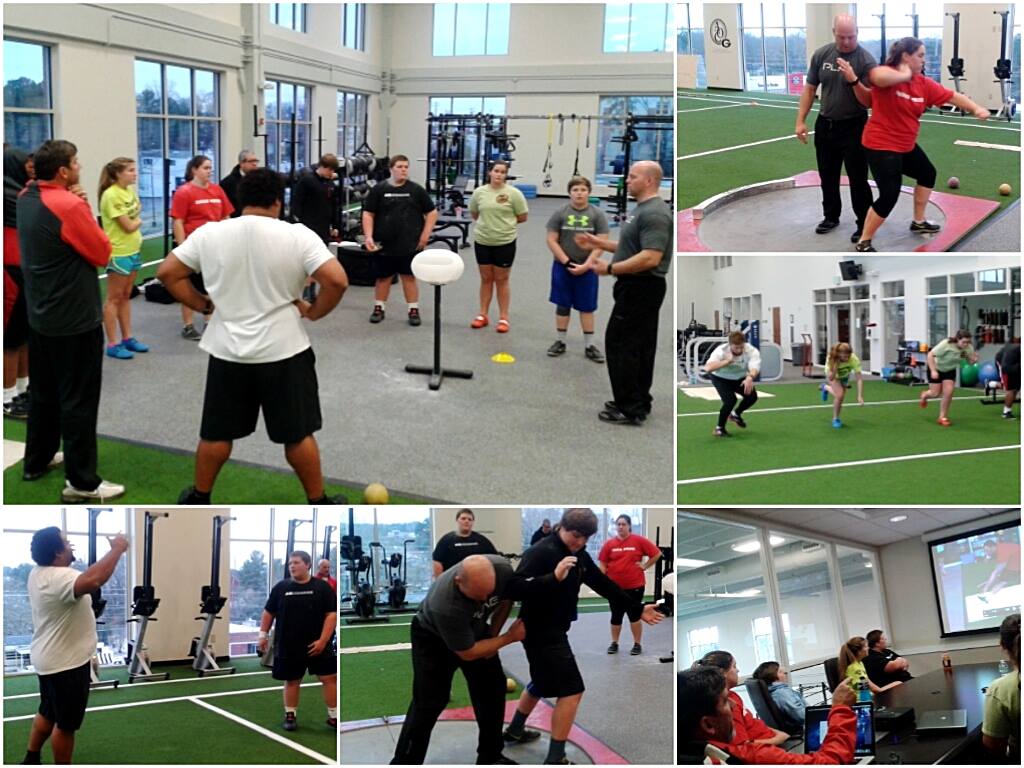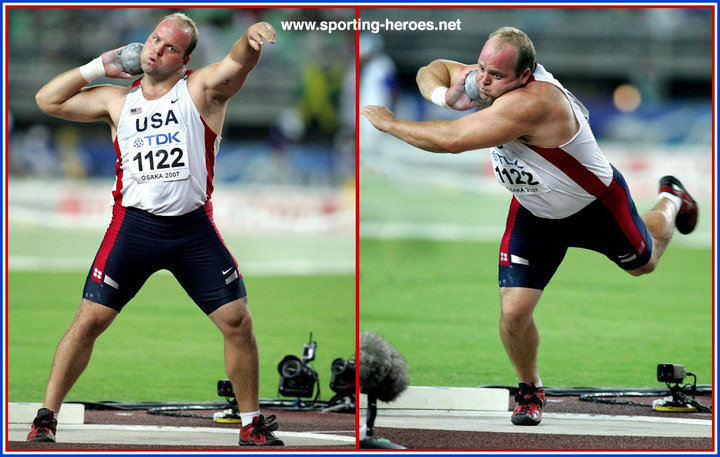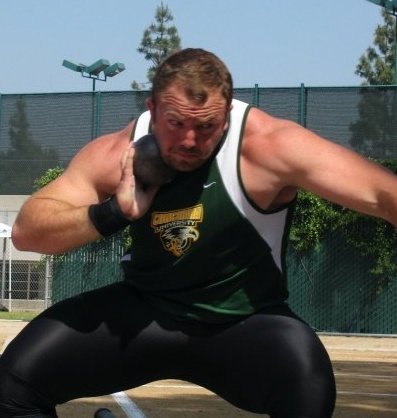Written by Team Juggernaut Adam Nelson is a certified legend in the sport of Track & Field. The 2004 Olympic Gold Medalist in the Shot Put, Nelson also has the 2000 Olympic Silver, 2005 World Championship Gold, 2001, 2003 and 2007 World Championship Silver Medals on his resume. Nelson was always a fan favorite for his trademark intensity, working the crowd into a frenzy before ripping off his shirt and charging into the ring to unleash all-time great throws like his PR of 22.51m (73’10”), which at the time it happened was the 3rd farthest throw in US History and the 9th farthest ever in the World. Nelson is a graduate of Dartmouth University and holds a Masters Degree from the University of Virginia. Adam now is the head performance coach at SPARC-Athens (GA) where he helps athletes achieve measurable results, while continuing to be active in the track & field community as an anti-doping advocate and member of the Track and Field Athletes’ Association…
Q: Thanks for taking the time to answer some questions Adam, this is a real honor for me as you have been a hero of mine for a long time. Tell us about what post track & field life is for Adam Nelson…
It’s funny. My career as a track athlete was almost by accident. At no point did I ever think I would stay competitive in the sport for 12 years, so early in my career I was much better about planning for the next phase of life. At that point, I truly believed I’d go in to financial markets and end up working as venture capitalist. When I finally did retire, I wasn’t in the same place mentally nor did I have the right network to pursue my original plan. So I had to ad lib a bit.
First thing, I got involved with the Track and Field Athletes’ Association. Track and field is a collection of independent contractors specializing in multiple disciplines who come together once in at a shared venue to compete in a shared venue. In some ways it’s similar to the different disciplines in the iron game – power lifting, olympic lifting, bodybuilding, etc – and the TFAA is working hard to build a collective voice across all disciplines in order build a stronger, more viable profession. It’s a lot of work, but I’m passionate about it.
Somewhere along the way I was approached by a group of doctors interested in opening a sports performance facility. They initially hired me as a part-time consultant and I am now working full-time as Director of the AOC’s Sports Performance and Rehabilitation Center (SPARC for short). We opened the doors for business in October of 2013. We have a long way to go before achieving my vision for our multi-sports training center that provides comprehensive training and rehabilitation platform for competitive athletes of all levels. As I learned in sports, success is rarely achieved overnight. It takes a lot of small victories over a long period of time to achieve greatness.
Most importantly, my current role has allowed me to start and operate a business without the same financial risks of doing it independently. That’s a great experience to have as my first “real” job. I’m always looking to learn more though. Chad, do you have any advice?

Q: You were recently awarded the gold medal from the 2004 Olympics due to Bilonog’s failed test. Tell us what that means to you and what you see needing to happen for anti-doping procedures to create a more level playing field worldwide…
I’m proud to say that I’m the only shot putter in history to win both an Olympic and World Championship Gold medal in back to back years. I’m even more proud to say that I did it the right way through out my entire career.
That said, winning the gold medal in this manner was bittersweet as it symbolizes a lot of the lost memories I never had. My “medal ceremony” happened in the food court of the Atlanta Airport in July of 2013. It looked more like a scene from a spy movie when two agents exchange secrets. I met with man I didn’t know. We sat a table in front of the chinese restaurant. He placed a box on the table and I placed my box on the table. We made the exchange and left. Nothing very Olympic about the moment. While it’s certainly unique, I think I would have preferred the traditional ceremony in Athens more. I’d be remiss if I didn’t mention the massive loss of financial opportunities.
Anti-doping policies that focus on detection will always be one step behind. Right now there’s an 8 year statute of limitations on retroactive testing. It appears that’s enough to make up for the distance between detection and dopers – at least with some protocols, but it’s not sustainable. Anti-doping policies are a modern day version of Nancy Regan’s “Just Say No” campaign. It’s a costly and ineffective way of dealing with the problem. To effect real change, you must address the cultural issue that supports drug use. This means incenting athletes, coaches, federations, and doctors to do it the right way.
In my opinion, the only way to do that is to reward athletes for the behavior you want. I would like to see something called the “Fair Play Fund” started and funded by the IOC, NOC’s, NGB’s, sponsors, and event directors. Essentially, athletes could accrue contributions through compliance with anti-doping. Failure to comply would result in reassingnment of funds back into the general fund for redistibution with compliant athletes. There’s a lot more to it than that, but I don’t want to bore you with details.
Check out Adam’s Gold Medal winning throw from the 2004 Athens Olympics…
Q: You were always known for your showmanship, unique technique and speed. What do you think made you such a successful thrower?
So aside from what you mentioned in your question – technique and speed, I think most of my success had to do with my ability to focus on what I needed to do to throw far. I didn’t spend much time worrying about what others were doing. So what if you could out lift me. I didn’t get paid for that. Focus on what’s important and remember everything else is an accessory lift to that.
Q: What were some of your most impressive lifting/jumping feats during your career?
I don’t want to misrepresent myself, but I didn’t really perform max lifts. It wasn’t really a focus in my training. I liked to work for heavy 2s or 3s or 5s. Those rep ranges usually allowed me target the correct energy system at a slightly lower risk of injury. I, also, had an unreal ability to do reps at relatively high intensity levels. For example as a 17 year old before my senior year high school during football testing I benched 225 for 42 reps, max benched at 435 and squatted 225 for 85 reps. I have no idea why we chose those exercises to test.
In the summer before my senior year in college my typical warm up in the bench went like: 135 x 20, 225 x 20, 315 x 10, 405 x 10, then I’d start my working sets. I remember doing 385 for 18 reps after working up to a 465 x 5 then finishing the workout with 225 for 47 reps. It may have been my dumbest and best bench workout ever. Another time after the Sea Ray Relays I worked up to 545 x 5 in the bounce pad bench press. We used two towels folded across our chest.
My best squat workout came in the spring of 1997 as well. The goal was to work to heavy 5. The previous 3 heavy squat days started at 585 x 5, 595 x 5 and 605 x 5 respectively. I think the last workout I went to 655 and then did some overweight supports with 735 or so. My goal was 665 x 5. My college coach, Carl Wallin, was spotting me that day. I was tightly belted with knee wraps. We had Guns N’ Roses blaring on the radio and my coach got the whole field events crew to come in to cheer me on. I crushed the first 5 reps. Carl yelled at me to do 2 more, I steadied the weight and hit another 2. Then, he said “10!” The place was going nuts. I felt the blood vessels in my face exploding when I hit 3 more. Carl yelled “2 more” at which point I told him “f*ck you” and collapsed forward into the safety rack.
My best jumps:
Vertical in 2000 taken at the Sydney Olympics – 39.5 inches
Broad Jump – I was reliably over 10’7 on a real good day over 11′. I used to do range jumps with a 10′ minimum line. I once got into a standing jump contest with Dwight Phillips at a training camp before the 2004 Olympics. Dwight’s probably the most successful long jumper in history. He couldn’t believe that a 260lb guy could possibly out jump him. We finished pretty much dead even.

Q: From a training standpoint, what means did you find to be some of the most effective tools for you?
When I first moved to Athens in 2001, the training group included Brad Snyder, Jason Tunks, Breaux Greer, Jay Harvard, and Andre Haklits. We usually lifted four days a week with one or two optional “gymnastics” sessions in the evenings. Don would run us through a series of different med ball throws, twists, leg raises, planks, etc. There was some structure to the overall program, but it was really more of a team bonding around core and mobility exercises.
Poliquin introduced me to more advanced types of periodization, integrated rehab protocols, a braoder exercise library, and tons of variations in loading protocols. The guy has an unreal amount of training knowledge. Up until I met Charles I followed a strict linear model. If I needed to peak, I would substitute my heavy lifting 2-6 weeks out with light speed days. I could usually hold a peak form for 8 to 12 weeks. Charles had me doing General Prep, Functional Hypertrophy, Accumulation, Intensification and Peaking programs. It was an eye opening experience. The programs varied tempo, rest, intensity, and exercises. We’d do slow tempos, isometric, and isometronic. We’d work full ranges, partial ranges and different angles. It was awesome.
That said most of my training for the first 10 of 15 years of my post collegiate throwing career focused more on general strength training. I didn’t fully appreciate specificity of training until much later. Charles would talk about it in his training, but we limited it to mostly similar movements targeting the right energy system. As I got older, I realized that I could apply many of the same principles in non-conventional lifting programs. I think that’s what allowed me to throw for so many years at a high level.
I didn’t really know much about Bondarchuk’s training until after I started experimenting with some programs of my own. I first started experimenting with these types of programs in late 1999 and 2000 after I tore my pec and realized I couldn’t train the same. My training shifted to something that resembled a modified jumpers program with more loaded carries and throws. At the time I don’t think I trusted myself enough to believe I could do it without hitting the weights hard, so I only trained this way when I had to – after an injury. And that’s a real problem with a lot of athletes. The weight room provides instant feedback. As a result it’s addictive, but the focus needs to be on the actual competition form.
As for exercises – I made things up. Sometimes you’re limited by the implements you have at your disposal. If you only have barbells, you have to get pretty creative. Ultimately, most of my specific training programs relied on plyometric movements with weighted throws. They have names like anterior loaded step up jump with toss or barbell elbow to opposite knee squats with press or medball jump front throws. The list goes on. The bottom-line: don’t be afraid to experiment. Just make sure you’re tracking the right thing.
Q: What do you make of the idea that the glide is better suited for international meet success than the rotational style?
I think the glide is a bit more predictable because it’s a simpler motion. It, also, compliments the really tall, power thrower.
The rotation levels the playing field for a better all around athlete. It gives the better athlete more time and distance to generate the power necessary to throw far.
I don’t think one is necessarily better than the other in international competition. I would say that you need to look beyond the techniques to the training programs that support the athletes. Both the Germans and the Polish have tremendous finanical and logistical support for their top athletes. This allows them to focus more exclusively on the major championships. It will be interesting to see what happens as other countries with similar Olympic programs develop world class spinners. My guess is that you will see more seasonal bests occur at the major championship as a result.

Q: What are some common mistakes you see being made in the training of young (high school/college) throwers and what advice would you give to rectify those? Any advice on how I was stand throwing 18m and only throwing 19.50m would be great too!
My guess is you tried to muscle the throw. It took me three years after college and a pec tear in 1999 to figure out how to finesse it. Throwing is really more about optimizing positions and patience. As strong guys we always want to crush the throw with our upper bodies. That doesn’t allow for a long push on the ball. It takes A LOT of patience to let your feet and your hips do all the work.
As for advice to the younger guys:
1) There are some real well known minimum strength levels necessary to throw the 16lb shot put. Use those normative numbers to structure your general strength training then spend your time honing your craft. I know first hand how addictive the weight room is. It’s provides instant feedback, but general strength has major diminishing returns.
2) Specificity of training requires a lot of maturity and a greater understanding / appreciation of why you train. If you’re still caught up in big numbers in the weight room, you will over train yourself within a month. You must believe in volume and power development through sub-maximal intensity workouts and you have to be anal about tracking the impact of your training on your performances and you have to be comfortable repeating the same workout over and over again.
3) Don’t worry about what everyone else is doing.
4) You are not entitled to anything except a lot of pain and frustration along the way. Celebrate the small, daily victories, because at the end of the day there can only be one winner in any competition but there are a lot of exceptional performances along the way.
Q: What does the rest of 2014 have in store for Adam Nelson
I started a sports performance facility in Athens, GA associated with a large orthopedic group. SPARCathens.com offers athletes of all ages and abilities the chance to train with world class strength and conditioning specialists, physical and massage therapists, and dietitian all under one roof. Our goal is measurably improve athletic performance and I think we’re pretty good at it.



